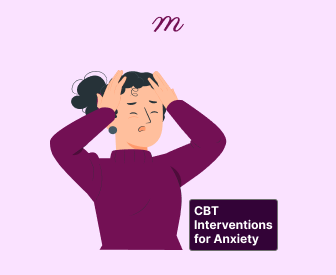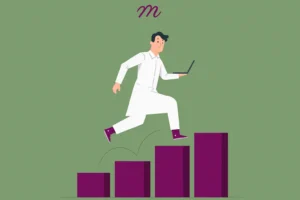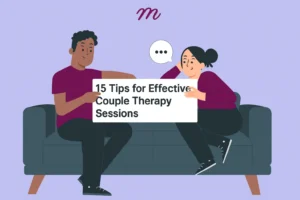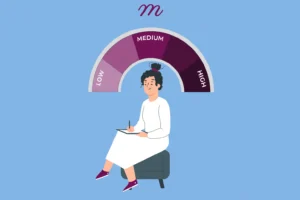Cognitive Behavioral Therapy Interventions for Anxiety
Anxiety disorders are among the most common mental health conditions that people deal with around the world, and Cognitive Behavioural Therapy (CBT) is one of the most prominent schools of thought for effectively managing anxiety and related concerns.
CBT and Anxiety
CBT posits that anxiety is an interaction of thoughts, emotions, bodily sensations, and behaviours. Take for example, Vikram, a 28-year-old software engineer who experiences intense social anxiety. His anxiety could look like this –
- Thoughts – "Everyone is going to judge me if I speak up in the meeting"
- Emotions – Intense fear and anxiety
- Physiological Rapid heartbeat, sweating, trembling
- Behavioural – Avoiding team meetings and not taking part in the discussions, falling sick before important meetings
Below listed are the most prominent CBT techniques used for anxiety management –
1. Cognitive Restructuring/ Reframing
Cognitive restarting involves making the client aware of their negative thoughts and helping them replace it with a more healthier cognition. Let us take the case of Lakshmi, a 35-year-old teacher who is diagnosed with generalized anxiety.
Cognitive restructuring involves helping her identify and challenge her anxious thoughts:
- Anxious Thought: "I am going to mess up this presentation, all the kids will be laughing at me"
- Cognitive Reframing: "I'm well-prepared, and even if it is okay to make mistakes, I will give my best"
The goal is not to eliminate anxiety completely but to develop a more realistic perspective. Mental health professionals can guide clients like Lakshmi through this process using: socratic questioning, evidence gathering,and through helping the client generate alternate thoughts.
- Socratic Questioning
It is a method of probing into the client’s ideas by asking thoughtful, open-ended questions. It challenges assumptions, the aim is to make the client aware of underlying beliefs, and encourages reflection by helping individuals examine their thoughts from different perspectives.
A therapist might ask Lakshmi probing questions like:
- "What is the evidence that suggests you will mess up the presentation?"
- "Have there been times in the past when you have not messed up and successfully given presentations?"
- "What would you tell a friend who had similar anxiety about presenting?"
These questions help Lakshmi examine her anxious thoughts, challenge her catastrophic thinking, and develop a more balanced perspective by encouraging self-reflection and logical analysis.
- Evidence Gathering
It involves collecting relevant information from credible sources to support or challenge a particular negative thought. Effective evidence gathering helps ensure that conclusions are well-supported and reasoned.
In Lakshmi's case, evidence gathering might involve –
- Collecting feedback from colleagues and students about her teaching abilities
- Tracking her actual presentation outcomes versus her fears by collecting objective evidence, Lakshmi can build a more realistic view of her competence and challenge the irrational beliefs driving her anxiety.
- Alternative Thought
It is a thinking technique that makes the client consciously seek out alternate perspectives and unconventional ideas beyond initial negative assumptions. It involves deliberately challenging existing unhealthy negative thought patterns and considering hypothetical scenarios, and deliberately seeking out viewpoints that differ from one's initial understanding.
For Lakshmi this could include:
- Brainstorming presentation scenarios beyond the worst-case outcome, for example what if it went well
- Imagining supportive student reactions
- Developing contingency plans for potential presentation challenges
2. Exposure Therapy
Let us take the example of Arjun, who experiences a phobia of flying. In this case, exposure therapy might be a helpful intervention. This technique is about a gradual and controlled exposure of the client to the anxiety-provoking situations:
Exposure hierarchy for Arjun's flight anxiety might look like –
- Firstly, it can involve just looking at airplane pictures
- Next could be watching videos of flights take off and land
- The therapist could now either encourage the client or with the client go to visit an airport
- The client can now engage in airplane simulation to grow comfort and familiarity of flying
- The client can start by taking short duration flight
When implementing exposure therapy, it is equally important to teach relaxation techniques like Jacobson's Progressive Muscle Relaxation (JPMR) as it equips the clients with immediate tools to manage intense anxiety during the exposure process.
Relaxation techniques assist in reducing physiological responses such as rapid heartbeat, consequently minimize overwhelm. Arjun can be engaged throughout exposure by learning to relax muscles and control his respiration too, rather than being. These strategies provide a psychological "safety net" that allows people to adjust and progressively become accustomed to anxiety-inducing stimuli, making exposure therapy more effective and lasting. The combination of exposure and relaxation techniques enables clients to gain resilience, confidence, and, eventually, alter their connection with the feared stimuli by providing tangible skills for managing their emotional and physical responses in real time.
3. Behavioural Activation
Anxiety often manifests in the way of social withdrawal and reduced activity. For example, consider Deepa, a 42-year-old homemaker who has depression with co-morbid anxiety. Due to her anxiety, she has restricted herself to her bedroom.
In this case, behavioural activation can be helpful where she will be encouraged to engage in certain activities. Since thought, affect and behaviour are interconnected, through behavioral activation Deepa might also create opportunities for positive thoughts and affect experiences.For Deepa this could mean –
- Identifying meaningful activities for example getting back to her old hobby of knitting
- Creating a schedule of engagement – stepping out once a week to buy groceries from her local stores
- Monitor mood levels through emotional charts and scales
4. Relaxation and Mindfulness Techniques
Teaching clients physiological regulation techniques can significantly reduce anxiety symptoms. Practical strategies include:
- Deep breathing exercises
- Progressive muscle relaxation
- Mindfulness meditation
- Guided imagery
Let us take the example of Rajesh, a 50 year old business executive who is struggling with panic attacks. For him, diaphragmatic breathing can be taught to him to serve as a powerful anxiety management technique. This breathing method focuses on engaging the diaphragm to promote controlled breathing that counteracts the rapid, shallow breathing during anxiety.
The technique consists of slowly breathing via your nose for 4 seconds, allowing the belly to expand while keeping the chest relatively stationary, holding your breath for 2 seconds, and then expelling through your mouth for 5-6 seconds. By doing this breathing for 10 minutes everyday, Rajesh will activate his parasympathetic nervous system, effectively restoring his heart rate, lowering his blood pressure, and lowering his cortisol levels. The longer exhale compared to inhale is designed to stop the body's fight-or-flight response, providing a physiological reset mechanism.
5. Guided Imagery
It is a CBT technique that involves creating through imagination – vivid, intentional mental visualizations that can lead a client into relaxation, reduce their stress, and manage anxiety. Practitioners along with the client construct detailed, calming mental scenes that engage multiple sensory experiences, helping to redirect attention from anxious thoughts and activate the body's relaxation response. This technique makes use of the mind-body connection, using imagination as a powerful tool to influence physiological and affect states.
For example – Sheela, a college student in India, who makes use of guided imagery as an anxiety management technique. She, and her therapist, created a detailed visualization of a peaceful Kerala (her hometown) backwater scene, complete with gentle waves, winding cutting across the coconut trees, and a peaceful houseboat. Whenever Sheela feels anxious during exam preparation, she closes her eyes, lays down on her bed and immerses herself in this serene mental landscape, allowing the vivid imagery to calm her racing thoughts and reduce stress responses.
6. Journaling
It is a writing based activity which posits that clients record their thoughts, emotions, and/or reflections. Journals do not have a fixed format, however, based on the client’s needs the therapist and the client can come up with a structure. Journaling serves as a self-reflective tool that helps people process big feelings, identify certain thought patterns, and gain insights into their emotional states. By creating a written record of their experiences, clients can track their progress, recognize triggers, and hence develop more adaptive coping strategies.
For example – Vikram, a 40-year-old teacher, maintains a structured journaling to keep his anxiety levels in check. His daily journal includes:
- Anxiety triggers (antecedents)
- Automatic negative thoughts that came up during that time
- Evidence challenging those negative thoughts
- Alternative and more balanced perspectives
- Emotional and physiological responses
By consistently documenting and analyzing his anxiety patterns, Vikram gains insights into his thought processes and develops more effective management strategies.
Conclusion
Cognitive Behavioral Therapy offers a very structured approach to managing anxiety by empowering clients to understand, challenge, and reshape their thought patterns, mood and behavioral reactions. In this article, we have discussed techniques relevant to CBT that can help in managing anxiety; however, a therapist must always consider that it is not a one size fits all approach. A professional must assess the client’s concern and then select the most suitable technique. The effectiveness of CBT varies based on individual circumstances, severity of anxiety, and personal commitment to the therapeutic process.
Why other mental health professionals love Mentalyc

“It immediately changed my quality of life, personally and professionally. I went from 3–4 hours a week of notes to 1 hour at most … that alone is invaluable personally and professionally.”
Owner/Independently Licensed Marriage & Family Therapist (IMFT)

“For those who have hesitations … It is a lifesaver. It will change your life and you have more time to be present with your patients.”
Licensed Clinical Social Worker

“Do yourself a favor, make your life easier. Use the tools that are readily available … I found Mentalyc to be one of the best tools that I’ve ever used.”
Licensed Marriage and Family Therapist

“If I were recommending this software to a colleague, I would tell them that it is the best thing that they could do for their practice.”
Licensed Professional Counselor







